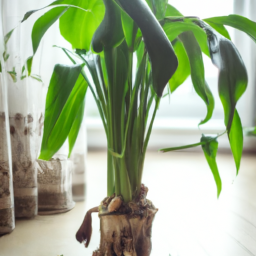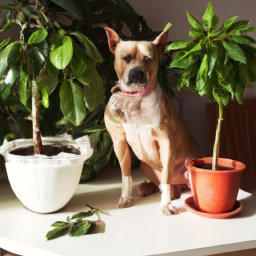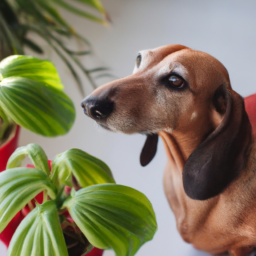
Are you a proud dog owner who loves to fill your home with lush greenery? While indoor plants can add beauty and freshness to any living space, it’s important to be aware of the potential dangers they may pose to our furry friends. In this blog post, we will explore the topic of indoor plants poisonous to dogs, shedding light on some common plants that can be harmful if ingested by our beloved canine companions. So, if you want to create a safe and dog-friendly environment while still enjoying the benefits of indoor gardening, keep reading to learn which plants to avoid and how to keep your four-legged friend out of harm’s way.
Common Indoor Plants that are Toxic to Dogs
Introduction
Indoor plants not only add beauty and freshness to our homes but also provide numerous health benefits. However, it’s important to be aware that some indoor plants can be toxic to our furry friends. Dogs, in particular, are curious creatures and may be tempted to nibble on plants, which can lead to serious health issues. In this guide, we will explore some common indoor plants that are toxic to dogs, helping you create a safe environment for your beloved pet.
Dieffenbachia (Dumb Cane)
Dieffenbachia, also known as Dumb Cane, is a popular indoor plant due to its attractive foliage. However, its leaves contain calcium oxalate crystals, which can cause oral irritation, intense burning, and swelling if ingested by dogs. Symptoms may include drooling, difficulty swallowing, and vomiting. In severe cases, it can even lead to asphyxiation due to swelling of the throat. If you suspect your dog has ingested Dieffenbachia, contact your veterinarian immediately.
To prevent any mishaps, it’s best to keep Dieffenbachia out of your dog’s reach or opt for pet-friendly alternatives such as Boston Fern or Spider Plant.
Philodendron
Philodendron is another popular indoor plant known for its lush green leaves. However, these plants contain insoluble calcium oxalate crystals, which can cause oral irritation, intense burning, and swelling if chewed or ingested by dogs. Symptoms may include drooling, pawing at the mouth, and difficulty swallowing. In some cases, it can also lead to vomiting and diarrhea.
To keep your furry friend safe, consider replacing Philodendron with pet-friendly options like Boston Fern, Areca Palm, or Parlor Palm, which can still provide a touch of greenery to your indoor space.
Pothos (Devil’s Ivy)
Pothos, also known as Devil’s Ivy, is a popular trailing plant often found in hanging baskets or cascading down shelves. While it adds a lovely touch to any room, it can be toxic to dogs if ingested. Pothos contains calcium oxalate crystals, similar to Dieffenbachia and Philodendron, which can cause oral irritation, intense burning, and swelling. Symptoms may include drooling, pawing at the mouth, and difficulty swallowing.
Consider replacing Pothos with pet-friendly alternatives like Boston Fern, Spider Plant, or Boston Ivy, which can provide a similar aesthetic appeal without posing a risk to your furry companion.
Conclusion
When it comes to creating a safe environment for our dogs, it’s crucial to be aware of the potential dangers lurking in our indoor plants. While the plants mentioned in this guide are common culprits, it’s important to research any new plants you bring into your home to ensure they are safe for your furry friend.
Remember, prevention is key. Keep toxic plants out of your dog’s reach, opt for pet-friendly alternatives, and always consult your veterinarian if you suspect your dog has ingested a toxic plant. By taking these precautions, you can enjoy the beauty of indoor plants while keeping your furry friend happy and healthy.

Symptoms and Treatment for Dogs Exposed to Toxic Indoor Plants
Introduction
Indoor plants can bring beauty and freshness to our homes, but it’s important to be aware that some of them can be toxic to our furry friends. Dogs, with their curious nature, may be inclined to chew or ingest these plants, leading to potential health issues. In this guide, we will discuss the symptoms of plant poisoning in dogs and provide you with essential steps for treatment. Remember, prevention is always the best approach, so being knowledgeable about toxic indoor plants can help keep your furry friend safe.
Symptoms of Plant Poisoning in Dogs
When a dog ingests a toxic indoor plant, it can lead to various symptoms depending on the plant and the amount consumed. It’s crucial to recognize these symptoms early on to seek appropriate treatment. Here are some common signs of plant poisoning in dogs:
1. Gastrointestinal Issues: Dogs may experience vomiting, diarrhea, drooling, or excessive salivation. These symptoms are often the first indication that something is wrong.
2. Oral Irritation: Some plants can cause irritation and inflammation in the mouth, resulting in pawing at the mouth, excessive licking, or reluctance to eat or drink.
3. Respiratory Distress: Certain toxic plants release airborne toxins that can irritate a dog’s respiratory system. Symptoms may include coughing, sneezing, difficulty breathing, or wheezing.
4. Skin Irritation: Contact with certain plants can cause skin irritation or allergic reactions in dogs. Look out for redness, itching, swelling, or hives on your dog’s skin.
5. Lethargy and Weakness: Ingesting toxic plants can make dogs feel lethargic, weak, or uncoordinated. They may show a lack of interest in their usual activities and exhibit reduced energy levels.
Treatment for Plant Poisoning in Dogs
If you suspect that your dog has ingested a toxic indoor plant or is displaying symptoms of plant poisoning, it’s crucial to take immediate action. Here are the steps you should follow:
1. Remove the Source: If you witness your dog consuming a toxic plant, try to safely remove it from their mouth. Be cautious, as some plants may have sharp or thorny parts that can harm both you and your dog.
2. Identify the Plant: Take a picture or keep a sample of the plant for identification purposes. This information will be helpful for veterinarians to determine the appropriate treatment.
3. Contact Your Veterinarian: Call your veterinarian or a pet poison control hotline immediately. Provide them with detailed information about the plant, the symptoms your dog is experiencing, and any relevant medical history. They will guide you on the next steps to take.
4. Follow Medical Advice: Based on the severity of the poisoning, your veterinarian may instruct you to induce vomiting at home or rush your dog to the clinic. It’s essential to follow their advice carefully to ensure the best possible outcome for your furry friend.
5. Supportive Care: Depending on the plant and the symptoms, your dog may require supportive care such as intravenous fluids, medications to control vomiting or diarrhea, or treatments for skin irritation. Your veterinarian will tailor the treatment plan to your dog’s specific needs.
6. Monitor and Prevent: After treatment, closely monitor your dog’s progress and follow any post-treatment instructions provided by your veterinarian. Take steps to prevent future incidents by keeping toxic plants out of your dog’s reach and creating a safe environment for them to thrive.
Conclusion
Being aware of the symptoms and treatment for dogs exposed to toxic indoor plants can help you protect your furry friend from potential harm. Remember to always research the plants you bring into your home and ensure they are safe for your pets. If you suspect plant poisoning, act swiftly and seek professional veterinary assistance. By taking these precautions and being proactive, you can create a safe and enjoyable environment for both you and your beloved four-legged companion.

Indoor Plants Poisonous to Dogs
Indoor plants not only add beauty and freshness to our homes but also provide numerous health benefits. However, it’s essential to be aware that some indoor plants can be toxic to our furry friends. Dogs, in particular, are curious creatures and may be tempted to chew on or ingest plants that can be harmful to their health. As a responsible pet owner, it’s crucial to understand which indoor plants are poisonous to dogs and take necessary precautions to keep our four-legged companions safe.
Identifying Toxic Indoor Plants
To ensure the safety of your dog, it’s important to familiarize yourself with the common indoor plants that can be toxic to them. Some of the most common toxic indoor plants for dogs include:
- Dieffenbachia: Also known as Dumb Cane, this plant contains insoluble calcium oxalate crystals that can cause oral irritation, drooling, and difficulty swallowing.
- Pothos: Pothos plants, including Devil’s Ivy, contain insoluble calcium oxalate crystals, which can cause similar symptoms as Dieffenbachia.
- Philodendron: Philodendron plants, such as the Heartleaf Philodendron, contain calcium oxalate crystals that can lead to oral irritation, excessive drooling, and difficulty swallowing.
- Sago Palm: The Sago Palm is highly toxic to dogs, as all parts of the plant contain cycasin, a toxin that can cause severe liver damage and even death.
- Snake Plant: Also known as Mother-in-Law’s Tongue, the Snake Plant contains saponins, which can cause gastrointestinal upset, including vomiting and diarrhea, if ingested by dogs.
These are just a few examples of toxic indoor plants for dogs, and it’s always best to research any specific plants you have in your home to ensure they are safe for your furry friend.
Creating a Pet-Friendly Indoor Garden
While it’s important to be aware of the toxic indoor plants, there are plenty of pet-friendly alternatives that can bring beauty and greenery to your home without posing a risk to your dog’s health. Here are three pet-friendly alternatives to toxic indoor plants:
1. Spider Plant
Spider plants (Chlorophytum comosum) are a popular choice for indoor gardening enthusiasts and pet owners alike. These plants are non-toxic to dogs and can thrive in a variety of lighting conditions, making them an excellent choice for any room in your home. Spider plants have long, arching leaves with white stripes, adding a touch of elegance to your indoor garden.
Not only are spider plants safe for dogs, but they also help purify the air by removing harmful toxins. They are known for their ability to absorb formaldehyde, carbon monoxide, and other volatile organic compounds, making them a healthy addition to your home environment.
2. Boston Fern
Boston ferns (Nephrolepis exaltata) are another pet-friendly option that can add a lush and tropical feel to your indoor space. These ferns have feathery fronds that gracefully arch over the pot, creating a beautiful display. Boston ferns thrive in humid environments, making them ideal for bathrooms or kitchens.
Not only are Boston ferns safe for dogs, but they also act as natural air humidifiers, helping to combat dry indoor air. They can also help remove toxins like formaldehyde and xylene from the air, promoting a healthier living environment for both you and your furry friend.
3. Areca Palm
Areca palms (Dypsis lutescens) are pet-friendly indoor plants that can bring a touch of the tropics to your home. These palms have graceful, feathery fronds that add a sense of elegance and relaxation to any space. Areca palms thrive in bright, indirect light and can tolerate some neglect, making them a low-maintenance choice.
Not only are Areca palms safe for dogs, but they also act as natural air purifiers, removing toxins like formaldehyde, benzene, and trichloroethylene from the air. They can help create a healthier and more refreshing environment for you and your furry companion.
Conclusion
As a pet owner, it’s crucial to be aware of the indoor plants that can be toxic to dogs. By identifying these plants and opting for pet-friendly alternatives, you can create a safe and beautiful indoor garden that both you and your furry friend can enjoy. Spider plants, Boston ferns, and Areca palms are just a few examples of pet-friendly plants that can enhance your home’s aesthetics while ensuring your dog’s well-being. Remember to always research any plants before introducing them to your home and consult your veterinarian if you suspect your dog has ingested a toxic plant.
Key Takeaways of this article
Indoor plants are a popular way to bring a touch of nature into our homes, but did you know that some of these plants can be harmful to our furry friends? It’s important to be aware of the potential dangers that certain indoor plants pose to dogs. While plants can provide numerous benefits, such as purifying the air and adding a splash of color, it’s crucial to choose ones that are safe for our four-legged companions.
Some common indoor plants that can be toxic to dogs include the popular peace lily, pothos, and snake plant. These plants contain substances that, if ingested by your dog, can cause a range of symptoms, from mild gastrointestinal upset to more severe reactions like difficulty breathing and even organ damage. It’s essential to keep these plants out of your dog’s reach or opt for pet-friendly alternatives. If you suspect your dog has ingested a toxic plant, it’s important to contact your veterinarian immediately and provide them with the necessary information to ensure prompt and appropriate treatment. By being aware of the potential dangers and taking precautions, we can create a safe and healthy environment for both our plants and our beloved pets.
Your Burning Questions Answered:
Q1: Are there any indoor plants that are poisonous to dogs?
A1: Yes, there are several indoor plants that can be toxic to dogs if ingested. It’s important to be aware of these plants to ensure the safety of your furry friend.
Q2: What are some common indoor plants that are poisonous to dogs?
A2: Some common indoor plants that are known to be toxic to dogs include lilies, philodendrons, pothos, snake plants, and peace lilies. These plants can cause various symptoms ranging from mild gastrointestinal upset to more severe complications.
Q3: What are the symptoms if my dog ingests a poisonous indoor plant?
A3: The symptoms can vary depending on the plant and the amount ingested. Common signs of plant poisoning in dogs may include vomiting, diarrhea, drooling, difficulty breathing, loss of appetite, lethargy, tremors, and in severe cases, organ failure. If you suspect your dog has ingested a toxic plant, it’s best to contact your veterinarian immediately.
Q4: How can I prevent my dog from accessing poisonous indoor plants?
A4: To prevent your dog from accessing poisonous indoor plants, it’s important to keep them out of reach. Place plants on elevated surfaces or use hanging baskets to keep them away from curious pets. You can also create physical barriers or use pet-friendly deterrents to discourage your dog from approaching the plants.
Q5: What should I do if my dog ingests a poisonous indoor plant?
A5: If you suspect your dog has ingested a poisonous indoor plant, it’s crucial to act quickly. Remove your dog from the area and try to identify the plant. Contact your veterinarian or a pet poison helpline immediately for guidance. Avoid inducing vomiting or administering any home remedies without professional advice, as some treatments may worsen the situation.
Dr. Olivia Green is a botanist with over two decades of experience in indoor plant cultivation. She holds a Ph.D. in Plant Biology and has dedicated her career to researching plant behavior in controlled environments. Dr. Green is passionate about helping plant enthusiasts master the art of indoor gardening through her extensive knowledge and practical insights.


